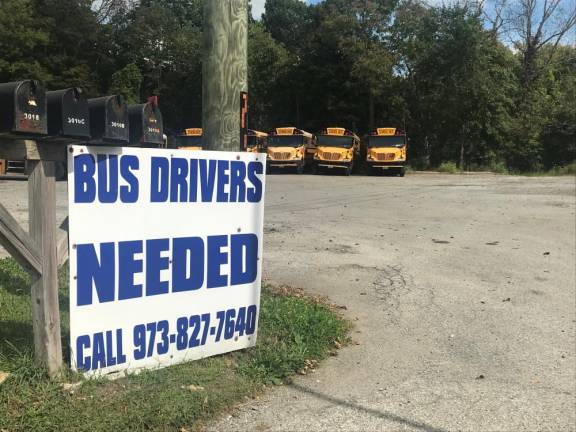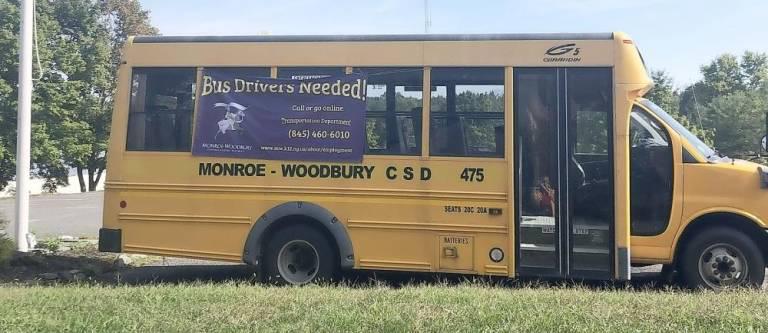‘It’s beyond anyone’s control’
Local school districts grapple with the shortage of bus drivers, resulting in delayed, crowded buses and longer ride times for students.


Across the country, a national shortage of bus drivers added another layer of disruption to the 2021 school year. Local districts have not been spared, resulting in delayed buses and longer rides for students.
In Orange County, there are job openings calling for bus drivers in nearly every school district. Goshen, Monroe-Woodbury and Warwick schools’ websites all advertise open bus driver positions on their employment pages.
‘It’s a national shortage’
In Sussex County, N.J., local school bus companies are posting hyper-competitive job-openings. First Student Inc., which is hiring in Lafayette and Andover, is offering $5,000 sign-on bonuses to drivers who already have the Commercial Driver’s License (CDL) and endorsements needed to operate a school bus; new drivers who don’t have those qualifications are being offered a $1,000 sign on-bonus and free training.
“It has been a challenge to say the least,” said Sparta School Superintendent Matt Beck, whose district unexpectedly started the year with a significant driver shortage and is still working to fix a couple of routes that are continuing to cause delays to and from school.
“The most frustrating thing about it is that it’s beyond anyone’s control,” Beck said. “It’s a national shortage.”
Like many local districts, Sparta schools contract their bus routes out to a handful of local companies, including Sussex County Regional Transportation Cooperative and Byram Bus. Over the summer, various transportation companies placed bids on the district’s routes, stating that they had the capacity to do so, and the district accepted them.
But between the time those bids were accepted and the school year officially started, the bus companies lost drivers and “can no longer fulfill our routes the way they were contracted. So they would double up their routes,” explained Beck.
He said one contractor was down seven drivers at the beginning of the year, and another was down 11.
‘A familiar story’
The story is a familiar one. Orange-Ulster BOCES, which buses special needs students in Orange County to various specialized schools throughout the Hudson Valley, faced the same roadblock.
“We’d been assured all summer that we had appropriate staffing in place and that we’d be good to go,” said Orange-Ulster BOCES operations director Mark Coleman. When the school year arrived, multiple drivers called out or did not return to work.
Where’d the drivers go?
A variety of factors could be keeping drivers from returning to work.
Unemployment benefits, fear of contracting Covid-19 and increasingly high pay rates and sign-on bonuses from competing bus companies are “the top three issues we’re facing right now,” said Coleman.
Administrators in Sparta and Vernon also said that some drivers, many of whom are older, decided to retire for good during the pandemic.
“Many drivers retired during Covid, some went out on unemployment when it started and just never came back,” said Marisa Broesder, transportation coordinator for the Vernon School District. “And some are afraid to come back because you’ve got nearly 54 kids on a bus all sitting in close quarters - it’s dangerous, you know.
“Another issue is we’re not getting through DMV fast enough either,” Broesder added. ”It takes anywhere from three to six months just to get a CDL. So even if you have people interested, it takes three to six months to get them actually working.”
New York seeks to speed process
New York State announced a plan last week in an attempt to speed up the onboarding process for new bus drivers, eliminating a 14-day waiting period between permit and road tests, and providing DMVs with assistance to allow more tests to be taken. As of publication, New Jersey had not announced similar plans to speed up the process.
Coleman, who estimated the bus service BOCES uses is about 19 drivers short, isn’t convinced that New York State’s assistance will be enough to move the needle.
“It still takes time,” Coleman said, “People have to understand the tremendous responsibility to have 40 kids on the bus and to be responsible for everybody’s safety, there’s a lot of training.
“I couldn’t hire you tomorrow,” Coleman added, “and have you drive a bus.”
Delayed buses, longer rides
The short supply of bus drivers led districts to combine bus routes to get kids to school, resulting in delays, longer rides and fuller busses - which in the age of COVID-19, poses a health risk.
“I know parents are concerned about the busses being crowded,” said Barbara Francisco, business administrator at West Milford Township Public Schools. “We’re trying so desperately to keep everybody healthy.”
Coleman said that there have been instances where Orange-Ulster BOCES students could not be picked up due to driver shortages, but that mostly, buses are running late - occasionally up to an hour.
“Not all of them, but more than we want,” he said. “We don’t want one kid being picked up late.”
In Vernon, “there’s definite delays,” said Broesder. “For one of my routes, the contractor does not have an afternoon driver. So they’re having another driver cover two routes, and that second route has to stay late at school. So they’re driving one route, and then driving as quickly as they can back to school to pick up the other route.”
Frustrations, from all quarters
The shortage has added a new level of frustration for districts and parents alike.
“Parents are upset, and rightfully so,” said Coleman. “And it’s the first thing the kid sees and experiences in the morning, and I feel bad, especially for some of the special needs kids - they really need routine. If we start their day off where a bus is not consistent, or they have a different driver or a different aid, that can be really disruptive to a kid’s day. We take that really seriously.”
And while getting to class on time is priority number one, athletics are also being affected. In Vernon, the transportation department is so low on drivers that it is working with coaches to possibly change practice and game times in order to supply adequate bussing.
“In a lot of cases with things that happen at school, we can fix them; we can throw a resource at it, we can offer a change,” said Coleman. “With the bus drivers, I just can’t say to the secretaries in the building, ‘You have to go drive a bus today.’ We can’t do it. It’s really frustrating because we’re letting kids down, and there’s no way we can fix it quickly.”